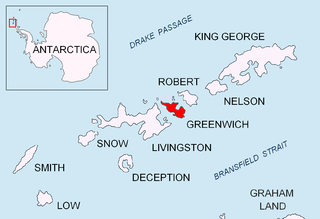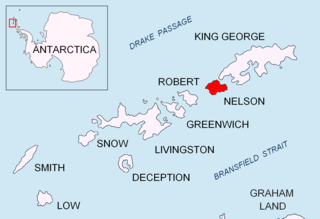
Dundee Island is an ice-covered island lying east of the northeastern tip of Antarctic Peninsula and south of Joinville Island.

Coronation Island is the largest of the South Orkney Islands, 25 nautical miles (46 km) long and from 3 to 8 nautical miles wide. The island extends in a general east-west direction, is mainly ice-covered and comprises numerous bays, glaciers and peaks, the highest rising to 1,265 metres (4,150 ft).

Lützow-Holm Bay is a large bay, about 220 kilometres (120 nmi) wide, indenting the coast of Queen Maud Land in Antarctica between Riiser-Larsen Peninsula and the coastal angle immediately east of the Flatvaer Islands. It was discovered by Captain Hjalmar Riiser-Larsen in two airplane flights from his expedition vessel, the Norvegia, on February 21 and 23, 1931. The name honours Commander Finn Lützow-Holm of the Royal Norwegian Navy Air Service, a pilot for Captain Riiser-Larsen on the Aagaard in 1935.
The Black River is a 41.1-mile-long (66.1 km) river on the Upper Peninsula of the U.S. state of Michigan, flowing mostly in Gogebic County into Lake Superior at 46°40′03″N90°02′57″W. Its source at 46°18′54″N90°01′15″W is a boreal wetland on the border with Iron County, Wisconsin. The northern section of the river, 14 miles (23 km) within the boundaries of the Ottawa National Forest, was designated a National Wild and Scenic River in 1992.

The Ibar Rocks are two rocks located 0.4 kilometres (0.2 nmi) east of Bonert Rock and 1 kilometre (0.6 nmi) southeast of Canto Point, Greenwich Island, in the South Shetland Islands. The names "Islote Ibar" and "Islote Teniente Ibar" appearing on Chilean hydrographic charts in the 1950s refer to the larger and western rock. The recommended name "Ibar Rocks" includes a submerged outlier to the northeast of the larger rock. Teniente (lieutenant) Mario Ibar P. signed the official act of inauguration of the Chilean Captain Arturo Prat Base on Greenwich Island in 1947.

Cove Rock is a low offshore rock 3 nautical miles (6 km) west of North Foreland, King George Island, in the South Shetland Islands. It was charted by Discovery Investigations in 1937 and called descriptively Cone Rock; the spelling Cove Rock, likely through error in transcription, appeared in a Hydrographic Office publication in 1942, and became established.

Growler Rock is a rock 1 nautical mile (2 km) northwest of Lions Rump in the western part of King George Bay, King George Island, in the South Shetland Islands. It was charted and named during 1937 by Discovery Investigations personnel on the Discovery II. The term "growler" is used to denote small pieces of ice barely showing above water.

Grace Rock is a rock in Bransfield Strait, Antarctica lying 1.72 kilometres (0.93 nmi) off the southeast coast of Nelson Island in the South Shetland Islands. It was named by the UK Antarctic Place-Names Committee in 1961 after the British sealing vessel Grace from Plymouth, which visited the South Shetland Islands in 1821–22.

Emm Rock is a conspicuous rock 30 metres (100 ft) high, lying 0.5 nautical miles (1 km) off the south coast of King George Island at the east side of the entrance to Potter Cove, in the South Shetland Islands. This rock, presumably known to early sealers in the area, was sketched by the French Antarctic Expedition, 1908–10, under Jean-Baptiste Charcot, and charted by Discovery Investigations personnel on the Discovery II in 1935. The name derives from the shape of the rock, which resembles the letter M.

Hale Glacier is a glacier about 6 nautical miles (11 km) long, located just east of Mount Simpson on Thurston Island, Antarctica, and flowing southwest to the Abbot Ice Shelf in Peacock Sound. It was delineated from air photos taken by U.S. Navy Squadron VX-6 in January 1960, and was named by the Advisory Committee on Antarctic Names (US-ACAN) for Lieutenant Bill J. Hale, U.S. Navy, a helicopter pilot aboard USS Burton Island who made exploratory flights to Thurston Island in February 1960.

Low Rock is a low rock surrounded by foul ground, lying 2 kilometres (1 nmi) southwest of Stranger Point, the southern extremity of King George Island, in the South Shetland Islands, Antarctica. An unnamed rock in essentially this position appears on a chart by David Ferguson, a Scottish geologist aboard the whaler Hanka, in these waters in 1913–14. Low Rock was more accurately charted by Discovery Investigations personnel on the Discovery II in 1935 and 1937.

Long Glacier is a glacier about 8 nautical miles long in the southeastern part of Thurston Island, Antarctica. It flows south to the Abbot Ice Shelf, 14 nautical miles (26 km) west of Harrison Nunatak. The glacier was mapped by the United States Geological Survey from surveys and U.S. Navy air photos, 1960–66, and was named by the Advisory Committee on Antarctic Names (US-ACAN) for Fred A. Long, Jr., an aviation machinist of U.S. Navy Squadron VX-6, who wintered at Little America V in 1957 and was in Antarctica in the 1960–61 and 1962–63 seasons.

Livonia Rock is a rock lying 0.5 nautical miles (1 km) south of Cape Melville, the eastern extremity of King George Island, in the South Shetland Islands, Antarctica. It was named by the UK Antarctic Place-Names Committee in 1960 for the sealing vessel Livonia from London, which visited the South Shetland Islands in 1821–22.

Hauken Rock is a rock lying nearly 1 nautical mile (2 km) east of the Ornen Rocks and 2 nautical miles (4 km) northeast of Cape Melville, the eastern extremity of King George Island, in the South Shetland Islands. It was named by the UK Antarctic Place-Names Committee in 1960 from association with Ornen Rocks. Hauken and Ørnen, the first two modern whale catchers, accompanied the floating factory ship Admiralen to the South Shetland Islands in January–February 1906.

Hole Rock is the largest of several rocks lying close north of North Foreland, the northeastly cape of King George Island, in the South Shetland Islands. It was charted in 1937 by Discovery Investigations personnel on the Discovery II and so named because a conspicuous hole extends through it.

Keep Rock is a small rock lying 1.5 kilometres (0.8 nmi) west-southwest of Castle Rock, off the west side of Snow Island, in the South Shetland Islands. The name, which derives from "keep" in association with Castle Rock, was given by the UK Antarctic Place-Names Committee following survey by Lieutenant Commander F.W. Hunt, Royal Navy, in 1951–52.

Limit Rock is a rock awash, lying 2 nautical miles (4 km) east of North Foreland, the northeast cape of King George Island, in the South Shetland Islands on the Southern Ocean. It was charted in 1937 by Discovery Investigations personnel on the Discovery II, and so named because it marks the eastern limit of foul ground surrounding North Foreland.












